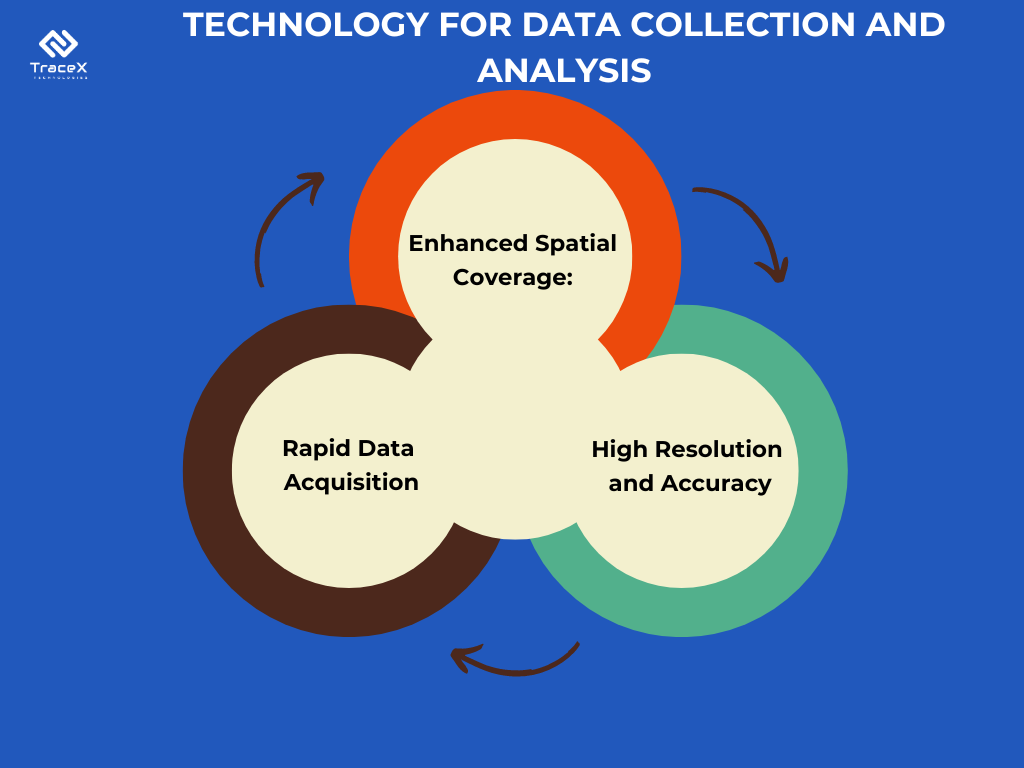Contact: +91 99725 24322 |
Menu
Menu
Quick summary: Discover the crucial role of tree monitoring in agroforestry and its impact on ecosystem health, carbon sequestration, and sustainable land management. Explore how advanced technology solutions, like TraceX, enhance monitoring practices for informed decision-making and environmental stewardship.

Agroforestry, the practice of integrating trees into agricultural landscapes, offers a multifaceted solution to some of the most pressing environmental challenges we face today. At the heart of this sustainable farming approach lies the crucial role of tree monitoring. In agroforestry systems, trees serve as more than just a source of timber or fruit; they act as vital carbon sinks, helping to mitigate climate change by sequestering carbon dioxide from the atmosphere.
Agroforestry is a sustainable land management system that combines agriculture and forestry practices, integrating trees into agricultural landscapes. One of the key benefits of agroforestry is its significant potential for carbon sequestration. Trees, through the process of photosynthesis, absorb carbon dioxide from the atmosphere and store it in their biomass, including roots, stems, branches, and leaves. This stored carbon helps mitigate climate change by reducing the concentration of greenhouse gases in the atmosphere. Agroforestry systems can sequester carbon in various forms, such as aboveground biomass, belowground roots, and soil organic matter. By harnessing the carbon sequestration potential of trees, agroforestry plays a vital role in addressing climate change and promoting environmental sustainability.
Effective tree monitoring is essential for maximizing carbon sequestration in agroforestry systems. Monitoring allows farmers and land managers to assess the growth and health of trees, optimize management practices, and quantify carbon storage potential accurately. By monitoring key parameters such as tree growth rates, biomass accumulation, and carbon stocks, stakeholders can make informed decisions to enhance carbon sequestration outcomes. Additionally, tree monitoring enables early detection of stressors such as pests, diseases, or adverse environmental conditions, allowing for timely intervention to mitigate risks and maintain tree health. Furthermore, monitoring facilitates the evaluation of different agroforestry practices and their respective impacts on carbon sequestration, guiding the adoption of strategies that maximize environmental benefits. Overall, robust tree monitoring programs are critical for ensuring the long-term success and sustainability of agroforestry initiatives aimed at mitigating climate change.
Agroforestry is a sustainable land management approach that involves integrating trees and shrubs into agricultural systems. Unlike traditional monoculture farming, which focuses on cultivating a single crop, agroforestry combines tree-based crops with traditional crops or livestock, creating a more diverse and resilient agricultural landscape. In agroforestry systems, trees play a crucial role in carbon sequestration, which is the process of capturing and storing atmospheric carbon dioxide (CO2) in biomass and soils.
Trees are highly effective at sequestering carbon dioxide through photosynthesis, the process by which they convert sunlight, water, and CO2 into organic compounds. As trees grow, they absorb CO2 from the atmosphere and use it to produce biomass, including leaves, branches, roots, and woody tissues. A significant portion of this carbon is stored in the tree’s biomass, while some is transferred to the soil through leaf litter, root exudates, and decomposition processes. Over time, this stored carbon contributes to the buildup of organic matter in the soil, enhancing soil fertility and structure.
Accurate carbon accounting is essential for quantifying the impact of agroforestry on carbon sequestration and assessing its contribution to mitigating climate change. Carbon accounting involves measuring and tracking carbon stocks and fluxes within agroforestry systems, including aboveground biomass, belowground biomass, and soil organic carbon.
By accurately measuring carbon stocks and fluxes, researchers and policymakers can evaluate the effectiveness of different agroforestry practices in sequestering carbon and identify opportunities for optimizing carbon storage. Additionally, robust carbon accounting enables the development of carbon offset projects, where carbon credits are generated based on the amount of carbon sequestered or avoided through agroforestry activities. These credits can then be sold or traded on carbon markets, providing financial incentives for farmers to adopt agroforestry practices and invest in sustainable land management.
Overall, accurate carbon accounting is critical for informing decision-making, incentivizing carbon-friendly practices, and maximizing the climate change mitigation potential of agroforestry.
Tree monitoring refers to the systematic collection and analysis of data related to the growth, health, and performance of trees within agroforestry or forestry systems. In the context of carbon projects, tree monitoring plays a crucial role in assessing the carbon sequestration potential of trees and quantifying the amount of carbon stored in aboveground biomass, belowground biomass, and soil organic matter. By monitoring trees over time, project managers can track changes in carbon stocks, identify factors influencing carbon accumulation, and evaluate the effectiveness of carbon sequestration efforts.
Tree monitoring is particularly relevant to carbon projects aimed at mitigating climate change, as it provides essential data for carbon accounting, verification, and reporting purposes. By accurately measuring and monitoring carbon stocks, project developers can quantify the carbon benefits of their activities, validate carbon offset claims, and ensure compliance with carbon standards and protocols.
By collecting and analyzing these data, project managers can gain valuable insights into the performance of trees within agroforestry systems and make informed decisions to optimize carbon sequestration outcomes.
Plot-Based Inventory: Plot-based inventory involves the establishment of sample plots within agroforestry or forested areas, where trees are systematically measured and monitored. Common plot-based methods include fixed-area plots, variable-radius plots, and nested plots, each tailored to specific objectives and vegetation types. These techniques allow for detailed assessments of tree attributes such as diameter at breast height (DBH), height, and species composition within defined sampling areas.
Remote Sensing: Remote sensing techniques, including satellite imagery, aerial photography, and LiDAR (Light Detection and Ranging), provide valuable tools for large-scale tree monitoring and mapping. Remote sensing data can be used to assess forest cover, canopy structure, biomass distribution, and land use changes over time. Advanced remote sensing platforms offer high spatial resolution and spectral capabilities, enabling accurate characterization of tree resources and carbon stocks across diverse landscapes.
1. Growth Measurements: Tree growth can be assessed through repeated measurements of key parameters such as DBH, height, and crown dimensions over time. Growth rates are calculated based on changes in these attributes, providing insights into tree development and productivity.
2. Biomass Estimation: Various methods are available for estimating tree biomass, including allometric equations, biomass expansion factors (BEFs), and direct measurements through destructive sampling. Allometric equations relate tree dimensions (e.g., DBH, height) to biomass components (e.g., stem, branches, foliage) based on empirical relationships derived from field data. BEFs are used to extrapolate biomass estimates from easily measurable parameters such as DBH or volume.
3. Carbon Stock Assessment: Carbon stocks in trees and associated vegetation are quantified by converting biomass measurements into carbon equivalents using species-specific carbon content factors. Soil organic carbon stocks are assessed through soil sampling and laboratory analysis, considering factors such as soil depth, texture, and organic matter content.
Standardized protocols and quality assurance measures are essential for ensuring consistency, accuracy, and reliability in tree monitoring activities. By adhering to established guidelines and best practices, data collected from different sources and locations can be harmonized and compared effectively. Standardization also facilitates data sharing, collaboration, and meta-analyses across research studies and projects.
Quality assurance procedures may include training and certification of field personnel, calibration and maintenance of measurement equipment, regular field audits and checks for data accuracy and precision, and documentation of protocols and procedures. Implementing robust quality control measures helps minimize errors, biases, and uncertainties in tree monitoring data, enhancing the credibility and trustworthiness of results for informed decision-making and policy development.
GIS technology integrates spatial data with attribute information to create visualizations, analyze patterns, and manage geographic information effectively. GIS platforms allow users to map tree locations, assess land cover changes, and overlay environmental variables for comprehensive analysis of tree resources and carbon stocks. GIS-based applications streamline data management, facilitate decision-making, and support planning and monitoring efforts in agroforestry projects.
Drones offer a versatile and cost-effective means of collecting high-resolution aerial imagery and LiDAR data for tree monitoring applications. Equipped with cameras, multispectral sensors, or LiDAR scanners, drones can capture detailed information on tree health, canopy structure, and biomass distribution with spatial accuracy. Drone-based surveys enable rapid data acquisition over large areas, enhancing efficiency and scalability in tree inventory and assessment activities.
Satellite remote sensing provides a valuable source of spatial information for monitoring tree cover, land use changes, and ecosystem dynamics over broad geographic scales. Satellite sensors capture multispectral and hyperspectral data, allowing for the detection of vegetation characteristics, biomass accumulation, and carbon sequestration rates over time. Continuous satellite monitoring facilitates long-term monitoring of agroforestry systems and supports assessments of carbon stocks and ecosystem services.

1. Data Collection Complexity: Tree monitoring often involves collecting vast amounts of data across diverse geographic areas, which can be challenging due to logistical constraints, terrain difficulties, and resource limitations.
2. Resource Intensity: Tree monitoring requires significant time, manpower, and financial resources, making it impractical for some organizations, especially small-scale projects or those operating in remote locations.
3. Data Accuracy and Consistency: Ensuring the accuracy and consistency of collected data poses challenges, particularly when using manual data collection methods, leading to potential errors, biases, or inconsistencies.
4. Technology Limitations: Dependence on technology for data collection and analysis can pose challenges, including technical failures, equipment malfunctions, or insufficient expertise in utilizing advanced monitoring tools.
5. Long-Term Commitment: Tree monitoring is often a long-term endeavor, requiring sustained efforts over extended periods to capture changes in tree growth, health, and carbon stocks accurately.
TraceX Digital MRV (Monitoring, Reporting, and Verification) solutions play a pivotal role in tree monitoring by providing a comprehensive platform for collecting, analyzing, and reporting tree-related data efficiently and accurately. Leveraging advanced technologies such as remote sensing, GIS (Geographic Information Systems), and mobile applications, TraceX enables real-time monitoring of tree growth, health, and carbon stocks across diverse landscapes. By automating data collection processes, streamlining data analysis, and facilitating seamless data sharing, TraceX enhances the efficiency and effectiveness of tree monitoring activities. Furthermore, TraceX’s digital MRV solutions ensure data integrity, consistency, and transparency, empowering stakeholders to make informed decisions, track progress, and demonstrate compliance with regulatory requirements and sustainability standards. Overall, TraceX contributes to maximizing the impact of tree monitoring initiatives by optimizing resource allocation, improving decision-making, and driving positive environmental outcomes.
In conclusion, tree monitoring stands as a critical pillar in the realm of agroforestry, offering invaluable insights into the health, growth, and carbon sequestration potential of trees within agricultural landscapes. By meticulously tracking and analyzing data on tree performance, agroforestry practitioners can optimize land management strategies, enhance ecosystem resilience, and mitigate climate change impacts. Furthermore, the implementation of advanced technology solutions, such as TraceX’s digital monitoring and reporting platforms, further amplifies the effectiveness of tree monitoring efforts, enabling real-time data collection, analysis, and decision-making. Embracing tree monitoring not only fosters sustainable agricultural practices but also contributes significantly to global efforts aimed at achieving environmental sustainability and biodiversity conservation.
